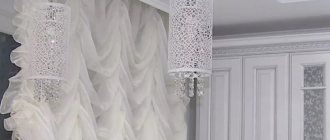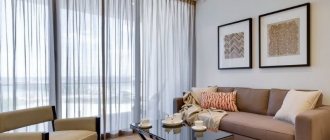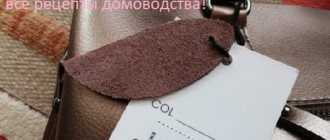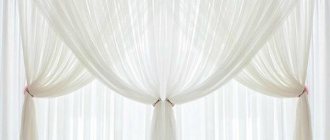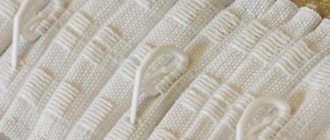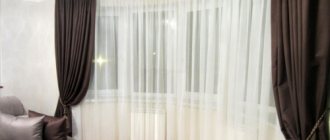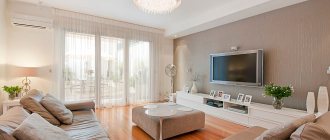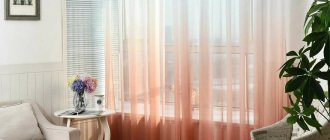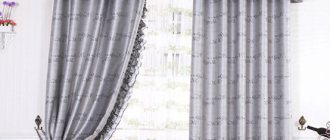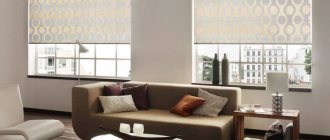Designers are happy to use light, flowy fabrics to decorate windows, giving the room a romantic, airy image. Such fabrics can be successfully used both as an independent element and as an addition to thicker curtains, depending on what effect you want to achieve with curtains in the room. The already huge range of lightweight fabrics is constantly updated with new products. One of these new products was semi-organza, or micro-veil. What unique combination of properties does this fabric combine?
What is a microveil?
Microveil combines the positive qualities of a veil - softness, sophistication - and organza - light transmission, elasticity. At the same time, microveil is a new type of fabric that deserves special attention. Possessing amazing thinness and transparency, semi-organza is incredibly flexible and durable; moreover, it is not subject to deformation, shrinkage and is resistant to ultraviolet rays. If you are looking for a thin fabric that can be draped into beautiful folds, microvoile is at your service.
What is a microveil suitable for?
Microveil can be successfully used in almost any interior, and all this is due to its transparency and good drapability. Microveil is made out:
- Windows - here it is used both as independent curtains and as an element of window design. Semi-organza is very good for dark rooms, where the design of the windows is aimed primarily at preserving all the sunlight that enters the room;
- Beds – a micro-veil looks no less magnificent as a canopy. You can use it for both a marital bed and a baby's cradle;
- Niches and false windows - the design of a niche usually involves the use of fabric, but heavy curtain fabrics look unsightly here and hide the space. In such a situation, a microveil will become an indispensable assistant.
False window decorated with semi-organza
Drawings and patterns
The choice of voile tulle is extensive, so it’s not difficult to find curtains to suit your own taste. Drawings and ornaments, embossing and embroidered elements, patterns and stripes - any of the listed decorative elements finds its place in interiors (pictured below).
Kitchen windows are decorated with flowers and monograms, embroidery is appropriate in the bedroom and living room, and an elegant stripe will complement the business atmosphere of the office.
A new direction in window design is the use of photo curtains. The themes of the drawings are different, which allows you to use tulle in different rooms. Still lifes are appropriate in the kitchen, scenes from cartoons are appropriate in the nursery, and imitation of luxurious embroidery or natural and city landscapes are chosen for the living room. Images on tulle can have clear outlines or be blurry and ghostly.
How to care for a microveil?
Semi-organza, despite its durability, requires careful care and delicate washing at low temperatures - up to 30⁰C. You can use any powder, however, if you need bleach, choose only the oxygen version, designed specifically for delicate fabrics. Curtains made from micro-veil should also be ironed carefully, in the most gentle mode or in the steam mode.
In our salon you will find a wide selection of fabrics for curtains: tulle, voiles, organza, semi-organza, etc. With us you can not only choose the appropriate material, but also order curtains made from it using.
Despite the growing popularity of blinds, many apartments still use curtains to decorate windows - patterned curtains, heavy drapes and light tulle fabrics. Among the various varieties of tulle, the most widespread are veil and organza. When choosing fabric for window decoration, it is necessary to take into account both the features of the interior of the room and the basic properties of the fabrics used for these purposes.
How to make a weighting agent: use cords or ribbons
The cord is attached to the bottom of the tulle, which adds some weight to the curtain. The thickness of the cord or cable is chosen taking into account the weight of the fabric itself, so as not to create excess or distortion due to the cord being too heavy. The cable is secured using a sewing machine with an overlock or zig-zag function. Cords are produced weighing from 15 to 125 g/m.
Tapes and gathers make the tulle heavier
The tape can be used in several variations
- turning the edge of the veil with a satin ribbon;
- a fringed ribbon is sewn along the bottom of the product;
- a combination of veil and organza in one curtain in the form of frills or fastening strips of fabric.
Veil
Features of the veil
The word “voile” is translated from French into Russian as “veil”. It consists of interwoven silk, cotton, wool or synthetic fibers and looks like a fine mesh.
Voile tulle is characterized by the following properties:
- easily transmits sunlight;
- easy to wash and does not require ironing;
- effectively hides minor flaws in windows or walls.
The disadvantage of the veil is its increased electrification, as a result of which dust and small debris quickly accumulate on this fabric. Because of this feature, it requires frequent washing. Voiles made from natural fibers often shrink when washed; this must be kept in mind when calculating the amount of fabric when purchasing.
How to sew tulle from a veil yourself
Sewing tulle at home is easy. If you have no experience in sewing, you can settle on a simple model. The veil is so good that any curtains will look light and airy.
Master class on sewing tulle from a voile:
- Draw a sketch of the future curtain on paper.
- Measure the width of the window opening and the height from the eaves to the floor. Calculate the required amount of material and curtain tape. If volumetric folds are planned, the window width should be multiplied by 3. For a small assembly, the multiplier is 1.3-1.5.
- Buy a veil and tailor the future curtain.
- Fold and stitch the edges.
- Sew (or glue) a transparent curtain tape with loops to the top edge, departing 0.5 cm from the top edge.
- Gather the veil a little and hang it on the cornice using hooks.
Ready-made voile curtains can be purchased in a store or ordered from a studio according to your own sketch. In comparison with the proposed option, they will seem more refined and beautiful, but a thing sewn with your own hands makes the interior especially cozy.
Plain or multi-colored, with a small pattern or large print, the veil always looks stylish and elegant.
Features of organza
For the production of organza, both natural fibers and synthetic and artificial materials are used. The properties of organza made from polyester or viscose are no worse than those of silk organza.
Organza has the following qualities:
- tensile strength;
- easily transmits light;
- solvent resistance;
- low creasing;
- wear resistance and durability.
Although this fabric looks light and airy, it differs from other transparent materials in its rigidity and durability.
Additional Information
Placing them inside cuffs and seams allows you to hide weights from prying eyes. Therefore, the choice of a suitable device is strictly individual. Almost anything you can pick up will do. Curtains are mainly complemented with plates and cords. Since these elements have an external part, it is very important that they complete the composition and bring it to perfection.
When it is planned to maintain the geometry of the curtain only at the corners, a special kind of plate is used. Most often, the delivery kit already includes mounting brackets. Such devices help fix the weighting material in the bottom hem.
For Roman blinds, weighting agents are selected in the form of:
- steel rod;
- plates;
- slats.
Particular attention should be paid to the selection of weights mounted on bath curtains. In this case, only a steel chain is suitable; occasionally it is replaced with rods and small balls. Another option is several magnets. This solution is optimal for a steel or cast iron bathtub. If it is made of other materials, it will not fit well.
Choosing between veil and organza
The main difference between a veil and organza is the greater pliability and softness of the former. The veil drapes easily, and the folds on it are airy and light. The veil is perfect for decorating a kitchen, dining room, bedroom, while organza is perfect for decorating a hall or living room.
The veil allows air to pass through much better than dense organza, which prevents the free flow of air exchange processes.
If you have difficulty choosing between a veil and organza, you can purchase a micro-veil that combines the advantages of both of these tulle materials. The softness of the veil is combined with the elasticity of organza. Microveil does not fade when exposed to direct sunlight, does not shrink and drapes perfectly.
About the types
It should be noted that curtains come in different types. So, classic curtains are a thin curtain and drapes made of dense and heavy fabric. Austrian curtains are fabric gathered with a cord into smooth horizontal folds. Romanesque curtains have a similar appearance to Austrian ones, but they are only folded using mounting tape. As a result, you get semicircular folds at the top, and drapery at the bottom.
London ones are cascading ones, where the tape holds the fabric in a raised position. As a result, the curtain becomes similar to a garland. But crossed curtains are made from two sheets of fabric, which are connected at the top, and at the bottom the sheets are pulled apart in different directions. Italian curtains are distinguished by the fact that they do not move completely apart. They are tightened with cords that are pulled to the ends of the cornice.
There are also Japanese curtains. They are made from smooth rectangles of fabric, which are complemented with rigid inserts at the bottom. Roman blinds are also flat sheets of fabric that, when folded, form horizontal folds. How are roller blinds similar to them, only the latter, when raised, are rolled into a neat roll of fabric.
Chinese curtains are usually made to fit the window and are decorated with a contrasting ribbon along the edge. The last type is bamboo curtains. They look like bamboo fabric, which is intertwined with natural threads. When raising the curtain, you just need to pull the cord and the fabric will curl into a roller.
Using plates
Plates, sometimes called slats, are sometimes used not only to add weight to the bottom edge of the canvas, but also to maintain beautiful angles. The slats can be mounted not only in the bottom section of the fabric, they can even be sewn into the sides. Thanks to this, the curtain will be perfectly even in shape, even on the sides.
The straightener for Japanese curtains is made in the slatted format, since the fabric panels should not have a single fold during their operation.
The weight of the plates varies, therefore, like the cords, they should be selected for each individual curtain. When hemming the bottom edge of the fabric, you should make allowance for the fact that slats are inserted there, which means that you should purchase plates before hemming the cut, since the width of the plates also varies. When hemming the material at the bottom, you should leave a pocket for the strip, and buy the material with the expectation that the edge will be hemmed to form a pocket. The weight of the slats is selected depending on the weight of the canvas.
Usually, along with the plates, all the necessary elements are sold so that they can be fixed to the curtain. Attaching the plate to the fabric yourself is not difficult if the material has been processed correctly.
Tips for choosing curtains
Finally, we offer you some useful recommendations on how to choose curtains. These tips will be useful for choosing curtains for any room. First of all, you should take into account that if the room is very narrow and long, then it is wiser to choose curtains with a horizontal pattern for the window. This will visually expand the premises. If the ceiling in the room is quite low, then curtains with a vertical pattern would look more appropriate. Due to this, you can visually “raise” the ceiling.
An important nuance is the color combination. So, if the walls in the room are decorated with a large and very bright pattern, then it is desirable that the same color scheme and pattern be repeated on the curtain fabric, at least partially. But it should be remembered that large patterns will be appropriate in spacious rooms. But a small pattern is an excellent option for small spaces. If we are talking about a geometric pattern, then such curtains will look good in a room whose walls are decorated in a single color scheme and are also decorated with geometric motifs.
What are the differences, transparency and density
To produce organza, strong and thin fibers are used. They are connected in pairs and twisted in a special way. To obtain a shimmering effect, some threads are pre-cut on special machines. Thanks to this technology, organza curtains are highly durable and rigid. The folds placed when sewing products hold their shape well and do not unravel.
The veil is formed using plain weave and resembles a mesh or gauze in structure. This soft fabric drapes better, however, the folds are looser and weighting agents are used to give them the desired configuration.
Organza has good light transmission and is ideal for dark rooms facing north. This transparent, shiny fabric fills the room with sunlight, sending reflections to its most remote corners.
If the room is too bright and you need to darken it, then you should choose a veil, which is a translucent fabric. It is also used in cases where it is necessary to disguise defects in walls or window openings: even significant flaws can be hidden behind a mesh surface and abundant draperies.
How to avoid mistakes
To avoid making common mistakes, pay attention to the weight of the weights and make a choice that matches the density of the fabric. Then the weight will not be too light or, conversely, too heavy. Choose accessories that match the color of the curtain if it is not possible to make a drawstring or pocket. For the bathroom, do not use wooden slats. They will last a short time due to humidity.
The weight can be sewn into a special pocket or secured to the outside of the curtains.
You should not sew a weighting agent along the entire length of the fabric; for heavy fabrics, placing it in the corners or hanging weights that are hung on a chain, on curtain tape or decorative twine is enough.
All the hassle associated with decorating window openings with tulle and using weights should bring joy and not be a problem. You can choose a product with a sewn-in weight, or purchase tulle with voluminous embroidery, which naturally makes the product heavier, but the choice will be limited and the effect will not be as perfect.
Application area
The difference between a veil and organza is that these materials are used in different rooms. The veil can often be seen in the kitchen, dining room, and office. Curtains made from this fabric look more formal and are designed in a classic style.
Organza sparkling with an abundance of colors brings a feeling of celebration to the room. Interior designers often use it to decorate living rooms, children's rooms or bedrooms. This fabric is great for decorating rooms in an oriental style.
In addition to the above, there are other differences between a veil and organza:
- rigid organza practically does not wrinkle, while the veil can form difficult to remove folds and creases;
- organza does not accumulate static electricity, and, therefore, does not attract dust particles, which is different from a veil, which needs to be treated with antistatic agents;
- With prolonged exposure to ultraviolet radiation, the fibers of the veil become thinner, which can lead to ruptures. Organza is resistant not only to bright sunlight, but also to many chemicals, so curtains made from it are more wear-resistant and durable.
Sizes and colors
The length of voile curtains can be slightly higher/lower than the window sill, on the floor, not reaching it by 5-8 cm, or exceeding the height of the room. In the latter case, the bottom of the curtains is draped on the floor.
Short tulle is appropriate in the kitchen. Products that do not touch the floor get dirty less and make it easy to wet clean underneath them. A floor-length veil looks more elegant and stylish.
Cornices are mounted on the wall above the window or on the ceiling.
Not so long ago, a refreshing white color was considered traditional for tulle. Today preference is given to pastel colors - milky, peach, light green, lavender, pink.
A rainbow veil combines several fabrics made in different colors and sets the mood for positivity, while tulle with an ombre effect differs from other multi-color curtains in its smooth transition of shades, which brings unusualness and sophistication to the interior.
Let us list the unifying properties
Both organza and veil are light, almost weightless fabrics. By adding them to the window ensemble, you can smooth out the heaviness of the curtains and introduce notes of warmth and airiness into the interior. In addition, they have some common characteristics:
- Compound. Initially, only natural silk was used for organza, and cotton fibers were used for veils. However, recently, instead of natural ones, artificial or synthetic threads are more often used. Tulles made of polyester or viscose are no worse than natural ones in their properties;
- Drapability. As mentioned above, both materials easily form folds, which allows them to be used when sewing lambrequins and other decorative details;
- Difficult to process. Both organza and veil are difficult to cut and capricious to sew. To prevent the lightweight fabric from slipping off the table, the surface must be covered with flannel, and paper must be placed under the fabric to ensure smooth machine stitching;
- Difficulties of care. It is best to wash tulle fabrics by hand or use the most gentle machine cycle. They should be dried in the shade and away from heating devices, and ironed only through a cotton cloth, setting the iron control to the “synthetic” position.
In addition, each of the materials is painted in many colors and shades. This allows you to perfectly select tulle fabric for any room.
Varieties
Before purchasing fabric for curtains, you need to know what types of tulle manufacturers offer. Only harmoniously selected material can successfully fit into the composition of the interior and give it completeness.
In addition to the organza and veil discussed above, these fabrics include:
In addition, each of these materials can be decorated in several ways:
- machine or hand embroidery;
- etching various patterns with chemical reagents;
- metallized coating;
- weaving lurex threads;
- printing ornaments or prints;
- decoration with sequins or rhinestones;
- laser perforation.
Chan-jean tulle fabrics, which change their shade from different angles, are popular. This is achieved by interweaving threads that differ slightly in color.
In addition, some fabrics are processed wet on special presses to obtain numerous creases, the so-called harvester fabric. There is also tulle crash with a pattern that imitates broken glass and many others.
Often light tulle fabrics, such as veil or muslin, are sold with a weighting agent. It is a tape into which metal plates or balls are sewn at equal distances. Weighting the fabrics ensures that the draperies laid during sewing do not diverge and the curtains retain their shape for a long time.
Which is better: with or without weighting?
Straighteners have slightly different functions compared to weights. The airiness and lightness of the fabric, capable of flying into the air with every slight movement of air, will bring a lot of trouble. Straightening the drapery structure after each opening of a window or door is not the most pleasant experience.
No weights needed
Weights will help return any complex drapery to its original position. Without straighteners and additional devices to weigh down the fabric, you can use curtains in dark rooms without air movement and the possibility of disturbing the design of the drapery.
Features of choosing tulle in the living room
Correctly selected curtains will help create a cozy home environment in the living room, conducive to relaxation or, on the contrary, make this room stylish and creative. Here are some recommendations from designers for decorating windows:
- For curtains and curtains, it is better to choose fabrics that match not only color, but also texture. For example, organza is more suitable for satin or brocade curtains, and a veil is more suitable for jacquard or velvet curtains.
- For a room with patterned wallpaper, you should choose plain curtains.
- Curtains made of voile in combination with curtains made of matting will fit well into a room decorated in the style of “country” or Provence, and in combination with tapestry - for “Baroque” or “classic”.
- Shiny organza will look best in a room with an oriental flavor, while matte organza will look best in rooms decorated in a Scandinavian style.
- If the living room is large, then you should choose curtains in dark colors, which will visually narrow the space. And the smaller the room, the lighter the curtains and curtains should be.
So, veil or organza, which is better for sewing curtains for windows. There is no definite answer to this question, since both fabrics have an attractive appearance and good functional qualities. Therefore, the right to choose remains with your desires, namely what you want to see on your window and how to combine it.
